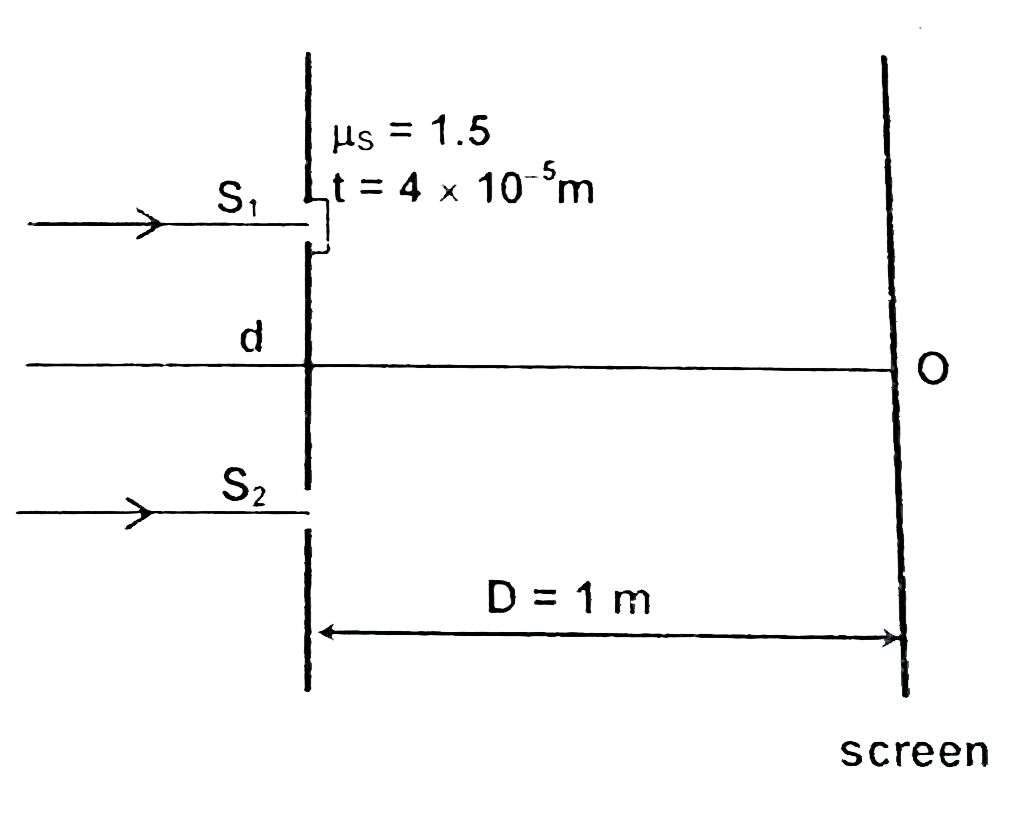A collimated beam of light of flux density 30kWm−2 is incident normally on 100mm2 completely absorbing screen. If P is the pressure exerted on the screen and △p is the momentum transferred to the screen during a 1000 s interval, then
P=10−3Nm−2
P=10−4Nm−2
△p=10−4kgms−1
△p=10−5kgms−1
The correct Answer is:B, D
To solve the problem, we need to calculate the pressure exerted on the screen and the momentum transferred to the screen during a specified time interval.
1. Identify the given values:
- Flux density (Intensity, I) = 30 kW/m² = 30 × 10³ W/m²
- Area of the screen (A) = 100 mm² = 100 × 10⁻⁶ m²
- Time interval (Δt) = 1000 s
- Speed of light (c) = 3 × 10⁸ m/s
2. Calculate the pressure (P) exerted on the screen:
- The formula for pressure due to light is given by:
P=Ic
- Substituting the values:
P=30×103 W/m23×108 m/s
- Simplifying this:
P=303×103−8=10×10−5=10−4 N/m2
3. Calculate the momentum transferred (Δp) to the screen:
- The formula for momentum transferred is given by:
Δp=P×A×Δt
- Substituting the values:
Δp=(10−4 N/m2)×(100×10−6 m2)×(1000 s)
- Simplifying this:
Δp=10−4×100×10−6×1000=10−4×10−4×103=10−5 kg m/s
4. Final Results:
- Pressure (P) = 10−4 N/m2
- Momentum transferred (Δp) = 10−5 kg m/s
Summary of Results:
- Pressure (P) = 10−4 N/m2
- Momentum transferred (Δp) = 10−5 kg m/s
- Flux density (Intensity, I) = 30 kW/m² = 30 × 10³ W/m²
- Area of the screen (A) = 100 mm² = 100 × 10⁻⁶ m²
- Time interval (Δt) = 1000 s
- Speed of light (c) = 3 × 10⁸ m/s
- The formula for pressure due to light is given by:
P=Ic
- Substituting the values:
P=30×103 W/m23×108 m/s
- Simplifying this:
P=303×103−8=10×10−5=10−4 N/m2
- The formula for momentum transferred is given by:
Δp=P×A×Δt
- Substituting the values:
Δp=(10−4 N/m2)×(100×10−6 m2)×(1000 s)
- Simplifying this:
Δp=10−4×100×10−6×1000=10−4×10−4×103=10−5 kg m/s
- Pressure (P) = 10−4 N/m2
- Momentum transferred (Δp) = 10−5 kg m/s
- Pressure (P) = 10−4 N/m2
- Momentum transferred (Δp) = 10−5 kg m/s
Topper's Solved these Questions
- BOOK - CENGAGE PHYSICS ENGLISHCHAPTER - PHOTOELECTRIC EFFECTEXERCISE - Multiple Correct10videos
PHOTOELECTRIC EFFECT
- BOOK - CENGAGE PHYSICS ENGLISHCHAPTER - PHOTOELECTRIC EFFECTEXERCISE - Linked Comprehension44videos
PHOTOELECTRIC EFFECT
- BOOK - CENGAGE PHYSICS ENGLISHCHAPTER - PHOTOELECTRIC EFFECTEXERCISE - Subjective16videos
PHOTOELECTRIC EFFECT
- BOOK - CENGAGE PHYSICS ENGLISHCHAPTER - NUCLEAR PHYSICSEXERCISE - ddp.5.514videos
NUCLEAR PHYSICS
- BOOK - CENGAGE PHYSICS ENGLISHCHAPTER - RAY OPTICSEXERCISE - DPP 1.612videos
RAY OPTICS
Similar Questions
Light is incident normally on a completely absorbing surface with an energy flux of 25Wcm−2 If the surface has an area of 25cm2 the momentum transferred to the surface in 40 min time duration will be:
View SolutionLight of wavelength 6328Å is incident normally on a slit having a width of 0.2mm. The distance of the screen from the slit is 0.9m. The angular width of the central maximum is
View Solution
Knowledge Check
- Question 1 - Select One
A parallel beam of light of wavelength 600 nm is incident normally on a slit of width d. If the distance between the slits and the screen is 0.8 m and the distance of 2nd order maximum from the centre of the screen is 15 mm. The width of the slit is
A40μmB80μmC160μmD200μm
Light of wavelength 6328Å is incident normally on a slit of width 0.2 mm. Angular width of the central maximum on the screen will be :
View SolutionLight with an energy flux of 18W/cm2 falls on a non-reflecting surface at normal incidence. The pressure exerted on the surface is
View SolutionA monochromatic light of wavelength 500nm is incident normally on a single slit of width 0.2 nm of produce a diffraction pattern. Find the angular width of the central maximum obtained on the screen.
Estimate the number of fringes obtained in Young's double slit experimental with fringe width 0.5mm, which can be accommodated within the region of total angular spread of the central maximum due to single slit.View SolutionMonochromatic light of wavelength 580 nm is incident on a slit of width 0.30 mm. The screen is 2m from the slit . The width of the central maximum is
View SolutionA parallel beam of monochromatic light of wavelength 5000Å is incident normally on a single narrow slit of width 0.001mm. The light is focused by a convex lens on a screen placed on the focal plane. The first minimum will be formed for the angle of diffraction equal to
View SolutionA parallel beam of monochromatic light of wavelength 5000Å is incident normally on a single narrow slit of width 0.001mm. The light is focused by a convex lens on a screen placed on the focal plane. The first minimum will be formed for the angle of diffraction equal to
View SolutionA coherent parallel beam of light of wavelength 5000A is incident normally on the plane of slits. The slit S1 is covered with a slab of refractive index μs=1.5 and thickness t=4×10−5m as shown. The separation between the slits is d=1mm and the separtion between the plane of slits and screen is D=1m. Then the position of the central maxima formed on the screen is
 View Solution
View Solution

